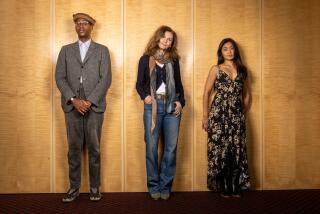A Few Bars of Mythic Resonance : WHAT DINAH THOUGHT: A Novel <i> by Deena Metzger (Viking: $19.95; 375 pp.; 0-670-82750-9) </i>
In “What Dinah Thought,” a 40-year-old New York film maker named Dina Z. goes to Israel, ostensibly to make a documentary. More to the point, she has become possessed by the spirit and voice of the biblical Dinah, the daughter of Jacob, whose story is told in the book of Genesis. At age 14, Dinah fell in love with Shechem, also 14 and a Hivite prince. After her family discovered she had lost her virginity to someone outside their own tribe of Israel, Shechem (despite his wish to marry Dinah) and many other male Hivites were murdered at the instigation of two of Dinah’s brothers.
Dina Z. tells her own story, but she often addresses it to Shechem by name, and there are italicized passages in which the biblical Dinah speaks too. Add that the author’s own first name is Deena, and these shifts and echoes in the narrator’s identity, while intriguing, make it hard to settle into the story.
Deena Metzger is interested in mythic resonance, of course, but as Marshall McLuhan pointed out, a myth is less a narrative than a complex of relationships. One has only to say the name Oedipus, or for that matter, Jesus, to evoke instantly an entire cosmology. In Israel, Dina Z. has a close friend, a writer named Sybil Stone, an erstwhile New Yorker, who is writing a biography of a legendary Israeli folk singer named Jeremiah Abazadik. The singer died in a mine-field explosion under circumstances that indicate he might have committed suicide. To the novel’s already dense patchwork of voices and epochs is added periodic installments from “The Testimony of Jeremiah Abazadik: A Posthumous Autobiography” written by Stone, who is as much possessed by Abazadik’s voice as Dina is by Dinah’s.
Two New York Jewish women in their 40s sharing a room in Israel while both hear the voices of the dead may sound like depressing material. However, it is only in these small-scale scenes of domestic forbearance that the book really comes alive. The two, routinely mutually exasperating, clearly love one another. Their intervals together involve suitcases, naps, looks and silences, and mostly ephemeral talk:
“ ‘Did you have another bad dream?’ Sybil sat up in bed.
“ ‘Another?’
“ ‘You’ve been sleeping fitfully. Tell me.’ She motioned me to her bed and I lay down next to her and told her the dream. . . .
“She stroked my hair. . . . ‘You’re like a little girl every time you get near anything that smacks of tradition or orthodoxy. That must be why you’re so feisty. . . .’ ”
Erza Pound wrote that the only thing that endures in writing is the quality of the emotion, and such passages in this otherwise overblown novel seem a clear case in point.
The “important” idea in “What Dinah Thought” is that Dina--in her own person now a reincarnated Dinah--will find in Israel a counterpart of Shechem--today, of course, a Palestinian--and the two will make love and simultaneously revise the Biblical myth and reverse the course of modern Israeli/Palestinian history.
When Dina encounters Jamine, the man she identifies as the Shechem figure, he rapes her. Later, in Palestinian territory, he pulls her against a barbed-wire fence; her blouse is ripped and she is bleeding. A page or two later, the blood has somehow disappeared or been forgotten, and Dina and Jamine end up making love on a hilltop twice in one night, first as themselves, the second time as their 14-year-old precursors.
Dina, as Dinah had before her, bears a child. Jamine, at first assumed dead after Dina’s return to New York, turns out to be alive. A rendezvous in Egypt is arranged for the lovers. All of this side of the story is told so portentously--with a couple of all-stops-out sexual crescendos--that there is no mistaking it for anything less than the stuff of legend.
However, the quiet scenes between the two old friends are the stuff of pleasure in a novel.
More to Read
Sign up for our Book Club newsletter
Get the latest news, events and more from the Los Angeles Times Book Club, and help us get L.A. reading and talking.
You may occasionally receive promotional content from the Los Angeles Times.







